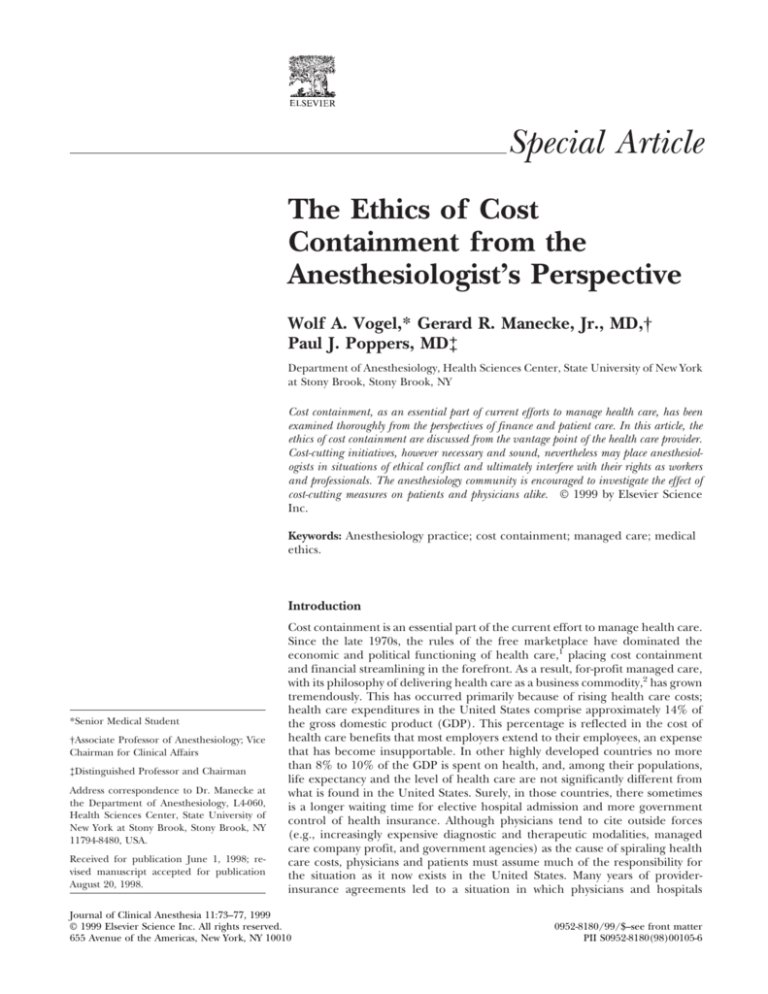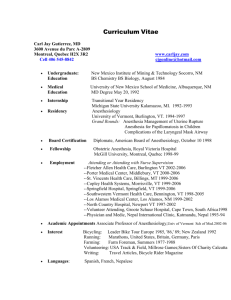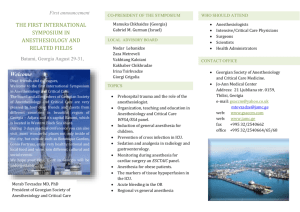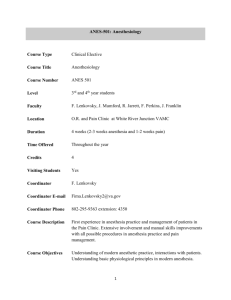
Special Article
The Ethics of Cost
Containment from the
Anesthesiologist’s Perspective
Wolf A. Vogel,* Gerard R. Manecke, Jr., MD,†
Paul J. Poppers, MD‡
Department of Anesthesiology, Health Sciences Center, State University of New York
at Stony Brook, Stony Brook, NY
Cost containment, as an essential part of current efforts to manage health care, has been
examined thoroughly from the perspectives of finance and patient care. In this article, the
ethics of cost containment are discussed from the vantage point of the health care provider.
Cost-cutting initiatives, however necessary and sound, nevertheless may place anesthesiologists in situations of ethical conflict and ultimately interfere with their rights as workers
and professionals. The anesthesiology community is encouraged to investigate the effect of
cost-cutting measures on patients and physicians alike. © 1999 by Elsevier Science
Inc.
Keywords: Anesthesiology practice; cost containment; managed care; medical
ethics.
Introduction
*Senior Medical Student
†Associate Professor of Anesthesiology; Vice
Chairman for Clinical Affairs
‡Distinguished Professor and Chairman
Address correspondence to Dr. Manecke at
the Department of Anesthesiology, L4-060,
Health Sciences Center, State University of
New York at Stony Brook, Stony Brook, NY
11794-8480, USA.
Received for publication June 1, 1998; revised manuscript accepted for publication
August 20, 1998.
Cost containment is an essential part of the current effort to manage health care.
Since the late 1970s, the rules of the free marketplace have dominated the
economic and political functioning of health care,1 placing cost containment
and financial streamlining in the forefront. As a result, for-profit managed care,
with its philosophy of delivering health care as a business commodity,2 has grown
tremendously. This has occurred primarily because of rising health care costs;
health care expenditures in the United States comprise approximately 14% of
the gross domestic product (GDP). This percentage is reflected in the cost of
health care benefits that most employers extend to their employees, an expense
that has become insupportable. In other highly developed countries no more
than 8% to 10% of the GDP is spent on health, and, among their populations,
life expectancy and the level of health care are not significantly different from
what is found in the United States. Surely, in those countries, there sometimes
is a longer waiting time for elective hospital admission and more government
control of health insurance. Although physicians tend to cite outside forces
(e.g., increasingly expensive diagnostic and therapeutic modalities, managed
care company profit, and government agencies) as the cause of spiraling health
care costs, physicians and patients must assume much of the responsibility for
the situation as it now exists in the United States. Many years of providerinsurance agreements led to a situation in which physicians and hospitals
Journal of Clinical Anesthesia 11:73–77, 1999
© 1999 Elsevier Science Inc. All rights reserved.
655 Avenue of the Americas, New York, NY 10010
0952-8180/99/$–see front matter
PII S0952-8180(98)00105-6
Special Article
provided care without consideration to cost, and by doing
so, in a sense, created their own market. In the United
States, governmental health insurance began in limited
form in 1965, with the institution of the Medicare program. Traditional indemnity insurance has persisted, however, preferred by the population at large. This type of
insurance led to prolonged hospitalizations, an increase in
the number of tests and investigations, and the use of
expensive medical equipment. Clearly, both patients and
physicians, encouraged by the medical technology and
pharmaceutical industries, share the responsibility for this
uncontrolled inflation of health care expense. Thus, the
health care industry is now faced with the necessity for
outside regulation and aggressive cost containment initiatives.1
The issue of cost containment, its effect on quality of
care, and the ethical implications involved have generated
considerable discussion both in the medical and nonmedical literature. Much has been written about conflicts
(physician self-interest versus the patient’s best interest),
the threat to the patient-physician relationship, and the
detrimental effects on patient care that some strategies for
cutting costs may create.3 Most discussions have focused
on the ultimate effect these pressures to contain costs have
had on the final product—patient care— or how they
impact on certain principles (e.g., autonomy, beneficence) from the patient’s perspective.4 We pose that an
ethics analysis of cost-containment strategies that focuses
purely on the effects on patient care from the patient’s
perspective is incomplete, and that the effects of cost
containment pressures on the physician from the perspective
of the physician as a stakeholder in the health care covenant
deserve careful consideration. We argue that cost containment efforts, if carried to extremes, may place physicians
in positions of conflict between their patients and their
institutions (employers?) and, consequently, interfere
with their rights as workers.
The Situation
Under pressure to succeed financially, medical institutions
are seeking to cut costs wherever possible. “Economic
credentialing”5 has become a gauge of physician performance and a predictor of remuneration (e.g., it determines whether or not a physician is eligible for a “year-end
bonus” from a managed care company).6 In addition to
economic credentialing, other financial incentives to contain costs include capitated reimbursement, other fee
withholds, and even unilateral termination of managed
care contracts by the managed care company.6 Under
these conditions, anesthesiology, with its costly intraoperative procedures, medications, and monitoring, attracts
greater scrutiny; anesthesiologists now face the problems
posed by cost containment.
The pressure to cut costs in anesthesiology is high.7 It
has been estimated that anesthesia accounts for approximately 5% to 6% of total hospitalization costs.8,9 Only half
of these costs are directly influenced by the anesthesiologist’s clinical decision making,8 particularly choice of
pharmaceuticals, with neuromuscular blocking drugs and
74
J. Clin. Anesth., vol. 11, February 1999
inhalational agents accounting for perhaps more than
50% of medication costs.9 Choice of medications, therefore, has become an easy target for cost-containment
measures, sometimes with considerable savings. Johnstone
and Jozefczk10 demonstrated a 23% savings in medication
budget as a result of the substitution of less expensive for
more expensive medications.
A 1-year study by Becker and Carrithers11 found a 13%
reduction in anesthesia drug costs with cost-containment
measures in one hospital. This amounted to a total savings
of $127,472 in a hospital with a yearly operating expense
of approximately $350 million.11 This figure may appear
to be a mere “drop in the bucket” with respect to total
operating expenses, but in this age of managed care and
decreasing profit margins, even such small amounts represent a disproportionately important percentage of the
hospital’s budget balance. Not surprisingly then, a survey
of 147 anesthesia departments found that 83% of respondents identified hospital administrators as the main source
of pressure to reduce costs.12 The same survey found that
in 53% of the institutions policies or guidelines existed to
reduce medication costs, and that in 48%, there were
policies concerning anesthesia items other than drugs.12
Expensive medications are an easy mark, but other
aspects of anesthesia care also have been targeted for cost
containment.7,13 These include, but are not limited to,
decreasing the number of preoperative tests, using outpatient ambulatory surgery centers instead of inpatient surgery, administering general anesthesia, which can be more
rapidly and therefore more economically induced than
regional anesthesia, limiting the use of blood products,
using low-flow anesthesia, re-using disposable breathing
circuits, reducing the use of warming blankets and monitoring devices, eliminating premedication with anxiolytics,
and avoiding wastage of materials and medications.11
As mentioned above, cost-saving measures in the operating room (OR) are not limited to those costs directly
controlled by the anesthesiologist.8 According to Valenzuela and Johnstone,12 “Costs of anesthesiology services
generally derive from three sources: the professional providers of care, the technology used, and the overhead
expenses of the facility where anesthesia is administered.”
Personnel costs contribute greatly to the overall expense
for OR time,14 accounting for perhaps more than 60% of
the average anesthesia department’s budget.7 In a survey
by Valenzuela and Johnstone12 of 147 anesthesia departments, 90% of respondents reported efforts to improve
operating room utilization. A different study in 1992
showed similar results with “the main cost containment
activity being the cost-efficient management of anesthesia
personnel.”12 Examples of such efforts include “crosstraining of personnel, replacement of scrub nurses by
operating room technicians, and a more flexible work
schedule arrangement to match supply and demand for
personnel.”13 Emphasis has also been placed on decreasing OR turnover time between cases.9 Many departments
are experimenting with part-time staffing and downsizing.9
Ethics of cost containment: Vogel et al.
Figure 1. Cost containment strategies in anesthesia on an ethical continuum.
The Ethical Continuum
Although hospitals must contain costs, it is clear that many
different approaches to cost cutting exist. One can envision cost-containing strategies as a continuum from ethically sound to ethically insupportable measures (Figure 1).
For strategies falling at either end of the continuum, the
issues are clear. For example, reducing the waste of
materials by shutting off the anesthesia machine and
suction when not in use, or choosing the less expensive of
two equally effective medications, is ethically sound. On
the other hand, such measures as cutting staff so that safe
coverage of cases is impaired, or withholding necessary
invasive monitoring, is clearly unethical.
Most cost-containment measures lie somewhere in the
intermediate “gray zone,” subjecting the anesthesiologist
to uncertainty as to whether his or her obligation of
providing optimal patient care is compromised. Clearly, if
the anesthesiologist could be reasonably certain that the
best interests of the patient were not undermined, then
these waters could be navigated easily. Unfortunately, for
the majority of these measures in the “gray zone,” such
information does not exist. Current research aims to
establish the effects of cost containment on quality of care
and patient outcome.15,16 Nevertheless, much remains
unclear or unknown.17 Moreover, some of what constitutes
the art of medicine may remain unquantifiable, and its
value may not become apparent under the scrutiny of
traditional research methods.
As physicians, anesthesiologists are trained to be caring
patient advocates and to have the paramount obligation
(ethically and professionally) to do what is best for their
patients.13 As individuals and medical staff, they also have
obligations to their families to earn a livelihood, and to the
institution where they practice. These pressures could, on
occasion, lead the anesthesiologist to place his obligation
to the institution and its ability to attract future patients
above the needs of the individual he is currently treating.
This could ultimately undermine the anesthesiologist’s
confidence in the level of care he can provide and lead
him to believe that this may be inimical to his professional
obligations. Ironically, as some anesthesiologists are pressured to forego certain invasive monitoring techniques,
they are still expected (and feel obligated) to provide
optimal care to a patient population that is aging and
growing more seriously ill. Anesthesiologists are trained to
be perfectionists, but they may feel compelled to practice
what they perceive to be mediocre medicine. The unseen
and as yet unrecognized emotional stress that this internal
conflict may have on the practitioner cannot be ignored.
Such stress and conflict is experienced on a daily basis
by many health care workers, not only anesthesiologists.2
Cost containment requires critical assessments of cost-tobenefit ratios. In some instances, however, the focus is on
cost, independent of benefit and quality of care.
Physician Rights and Business Obligations
In this consideration of the ethics of cost containment, the
interests and welfare of the patient are clearly paramount.
Nevertheless, one should not lose sight of the needs and
rights of the health care providers who strive for optimal
patient care. If one accepts the idea that the workers have
J. Clin. Anesth., vol. 11, February 1999
75
Special Article
certain inalienable rights (i.e., the right to receive fair
wages, to have safe working conditions, and work satisfaction), then one must also accept that the employer is
ethically obligated to respect those rights, and that the
employer-employee relationship is a social contract as well
as an economic one.18
As health care gradually shifts from a cottage industry
model to an industrialized business, and the position of
physicians moves from self-employment to being employed, new workplace pressures are being placed on
them. Instead of being free to decide courses of treatment
based solely on perceived patient needs, doctors must
consider a third party in the traditional doctor-patient
relationship—the insurer. Pressures to protect profits
through cost-cutting strategies create a new set of ethical
problems for physicians. The emphasis on cutting costs,
from the physician’s perspective, may create a work environment that prevents the anesthesiologist from being
certain that he has provided the excellent care he is
obligated to deliver and for which he is trained. This has
the potential to undermine the physician’s right to be able
to do meaningful and satisfying work. As professionals
whose work encompasses alleviation of suffering and the
compassionate attempt to heal the sick and injured, it is
likely that the ethical standards of physicians are, on the
average, higher than those of workers in other fields.
Therefore, one might expect that pressures to deviate
from the highest standards of care in the expectation of
ensuring greater profits would create painful dilemmas for
physicians. Additionally, the pressure to cut costs promotes staff downsizing and cross-training, situations that
may contribute to low morale. This can cause a potentially
hostile or harried work environment. These pressures, if
they interfere with workers’ rights, become ethically suspect.
This potential conflict between the rights of workers
and the interests of the employer is ubiquitous in business.
For example, in 1967, the B.F. Goodrich Company won a
lucrative new contract to build brakes and wheel assemblies for a new Air Force jet.19 The junior engineer
assigned to the project discovered a serious design flaw.
Bringing it to the attention of the senior engineering staff,
he was coerced into falsifying prototype test data so that
production could continue. The test flights were plagued
by brake problems resulting in several near crashes, almost
killing the test pilot.
Within the continuum of cost containment measures
discussed earlier (Figure 1), the B.F. Goodrich case clearly
falls in the black zone. Although this is an extreme case of
infringement on the right to satisfactory working conditions, one should consider whether the environment
created by the current cost-containing strategies in health
care similarly diminishes, though to a lesser extent, the
sense of professionalism and job satisfaction.
Historically, the employer-employee relationship in
United States business has been ruled by the “employment-at-will” (EAW) doctrine, an implied legal agreement
in effect since the 1884 court case Payne v. Western A.R.R.
Co.18 Essentially, it states the belief that employers have the
right to terminate employment without giving a reason,
76
J. Clin. Anesth., vol. 11, February 1999
and an employee can quit whenever he desires. However,
since the 1930s, state and federal legislation has altered
the EAW doctrine and defined the employer-employee
relationship as a social contract of rights and obligations
beyond the narrow scope of EAW.18 Employees have
certain rights, which imply a legal and moral duty on the
part of the employer: “Employers are obliged to pay
employees fair wages, to provide safe working conditions,
and to provide meaningful work.”18 The obligation to
provide meaningful work refers to the environment in
which the work is done as well as the nature of the work:
“Employers are obliged to offer employees working conditions that provide meaningful work and job satisfaction.”18 Employees also have certain moral rights (moral
entitlement) by virtue of being human beings.20 Moral
entitlements are nonnegotiable (e.g., the right of due
process) and represent “a general and presumptive moral
entitlement of any employee to receive certain goods to be
protected from certain harms in the workplace.”18
Most ethicists concede that with respect to business,
“without ethics the only restraint is the law.”21 In medicine, as in business, it is far better (and probably necessary) to promote ethical standards in order to protect all
parties. Zoloth-Dorfman and Rubin state the following:
. . . the growth of the managed-care marketplace can in many
ways be compared to the rapid growth and economic vigor of the
unfettered marketplace of the 19th century, which was based on
an understanding and ingenious grasp of new technologies and
new financial instruments. However, then, as now, what is needed
is careful social review and discussion about the limits and
excesses of such a system, and the staunch ethical and legal
protection of those who are most vulnerable and who are
therefore most likely to be harmed: workers and consumers.2
Different schools of thought exist among ethicists on the
extent of social responsibility that business holds. Generally speaking, they range from a productivist model, which
poses that the sole responsibility of business is to make a
profit, directly satisfying stockholder expectations, to a
stakeholder model of ethical idealism, which contends
that business should help workers realize their human
potential and that profits should be used to bring about a
more humane society.18 Stakeholders include the “customers, suppliers, the community, [and] employees.”22
Obviously, there is a spectrum of views within the extremes.
Although practically speaking, business is not expected
to adopt a stance of radical ethical idealism, it can be
argued that the business of managing the health care of
human beings and their right to high-quality care lends
itself to a progressive model of social responsibility. Elizabeth Vallance, business ethicist and chairman of St.
George’s Healthcare Trust, states:
The ethical corporation is not defined as one which abides by
legislation; ethics is not merely compliance. Rather, the ethical
corporation will normally obey the law as the basic minimum
response in any problematic situation in which it finds itself. But
it will do more than this: it will be aware of its obligations to those
Ethics of cost containment: Vogel et al.
inside and outside the company who are affected by its actions
and whose interests will be reflected in its values.23
This includes, of course, a recognition of the basic rights
of those workers involved in producing the business’
end-product.
The environment for health care professionals today is
little different from that in industry mentioned above; it is
just a matter of degree. Health care reform and the
managed care market have made some physicians direct
employees of managed care organizations and/or hospitals. Managed care companies now control such a large
share of the market (“covered lives”) that many physicians
have no choice but to contract with these agencies, lest
they have so few patients that they cannot earn a living.
When seen as employees, physicians, as well as other
health care providers, have the same inalienable rights as
employees in the general workforce. Consequently, the
environment and working conditions in which physicians find
themselves, i.e., those created by the pressures of cost
reduction, must protect the rights of the physician-workers. Although the strategies employed for cost containment are not inherently morally or ethically unacceptable,
if these strategies and pressures infringe upon the rights of
the employees, they approach being of questionable ethics. In the case of anesthesiologists, if their working
environment is affected by cost-cutting measures to the
point where they cannot practice according to accepted
professional standards (thus far we do not believe this is
the case), their rights as workers will be infringed upon.
Ironically, at a time when research is most needed to
clarify the effects on patient care of cost-containing strategies in the “gray zone,” economic pressures are forcing
many departments to reduce or eliminate the amount of
research performed.14 It is highly desirable that anesthesiology departments continue to investigate the effects of
cost containment on patients and physicians alike. It is
equally desirable that anesthesiologists (and other health
care professionals) take an active role in protecting the
ethics of their practice from extraneous considerations.
The goal should be to ensure that the anesthesiologists’
professionalism and, ultimately, patient care are not
threatened.
References
1. Shapiro BA: Why must the practice of anesthesiology change? It’s
economics, doctor!. Anesthesiology 1997;86:1020 –2.
2. Zoloth-Dorfman L, Rubin S: The patient as commodity: managed
care and the question of ethics. J Clin Ethics 1995;6:339 –57.
3. Sulmasy DP: Managed care and the new medical paternalism.
J Clin Ethics 1995;6:324 – 6.
4. Pelligrino ED: Interests, obligations, and justice: some notes
toward an ethic of managed care. J Clin Ethics 1995;6:312–7.
5. Longnecker DE: Navigation in uncharted waters. Is anesthesiology on course for the 21st century? Anesthesiology 1997;86:736 – 42.
6. AMA Council on Ethical and Judicial Affairs: Ethical issues in
managed care. JAMA 1995;273:331–5.
7. Orkin FK: Moving toward value-based anesthesia care. J Clin
Anesth 1993;5:91– 8.
8. Orkin FK: Meaningful cost reduction. Penny wise, pound foolish.
Anesthesiology 1995;83:1135–7.
9. White PF, White LD: Cost containment in the operating room:
who is responsible? J Clin Anesth 1994;6:351– 6.
10. Johnstone RE, Jozefczk KG: Costs of anesthetic drugs: experience
with a cost education trial. Anesth Analg 1994;78:766 –71.
11. Becker KE Jr, Carrithers J: Practical methods of cost containment
in anesthesia and surgery. J Clin Anesth 1994;6:388 –99.
12. Valenzuela RC, Johnstone RE: Cost containment in anesthesiology: a survey of department activities. J Clin Anesth 1997;9:93– 6.
13. Watcha MF, White PF: Economics of anesthetic practice. Anesthesiology 1997;86:1170 –96.
14. Jones RL, Plantes K: Cost containment in anesthesiology: a survey
of the association of anesthesia clinical directors. J Clin Anesth
1994;6:409 –10.
15. Freund PR, Bowdle TA, Posner KL, Kharasch ED, Burkhart VD:
Cost-effective reduction of neuromuscular-blocking drug expenditures. Anesthesiology 1997;5:1044 –9.
16. Lubarsky DA, Glass PS, Ginsberg B, et al: The successful implementation of pharmaceutical practice guidelines. Analysis of
associated outcomes and cost savings. SWIPE Group. Systematic
Withdrawal of Perioperative Expenses. Anesthesiology 1997;86:
1145– 60.
17. Fisher DM, Macario A: Economics of anesthesia care. A call to
arms! Anesthesiology 1997;86:1018 –9.
18. Weiss JW: Business Ethics. Belmont, CA: Wadsworth Publishing
Co., 1994.
19. Vandivier K: Case study—the aircraft brake scandal. In: Donaldson T, Werhane PH (eds) Ethical Issues in Business—A Philosophical
Approach, 3d ed. Englewood Cliffs, NJ: Prentice Hall, 1988:290 –
303.
20. Velasquez MG: Business Ethics—Concepts and Cases, 2d ed. Englewood Cliffs, NJ: Prentice Hall, 1988.
21. Cavanagh GF: American Business Values, 3d ed. Englewood Cliffs,
NJ: Prentice Hall, 1990.
22. Brigley S, Vass P: Privatised ethics—the case of the regulated
utilities. In: Davies PWF (ed): Current Issues in Business Ethics. New
York: Routledge, 1997:157.
23. Vallance E: Business Ethics at Work. New York: Cambridge University Press, 1995.
J. Clin. Anesth., vol. 11, February 1999
77







